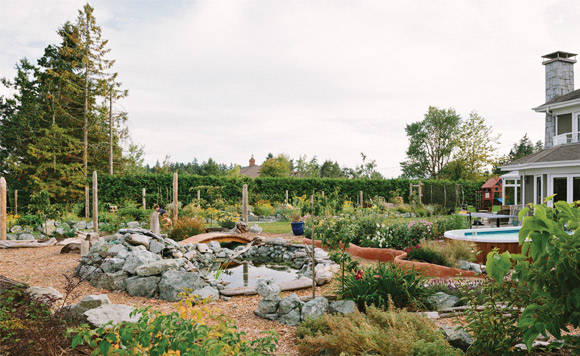by Solara Goldwynn, Hatchet & Seed –
Although almost any time of year is a good time to garden here on the West Coast, April is that special month when soil temperatures warm up and things really begin to grow. Seeds germinate quickly, fruit trees begin to bloom and the garden literally comes alive with the buzz of pollinators.
The concept of edible landscaping, or cultivating food around human habitat, is nothing new. Humans have been growing food around their dwellings in all cultures and places for a very long time. It’s only quite recently, in terms of human history, that we’ve become distant from our food sources, going global with our food, and growing lawns around our dwellings.
Yet, as we become increasingly aware of the costs of a global food system, more and more people are coming back to the idea of growing food where they live.
As edible landscapers, my husband and I work with many different clients to create landscapes that are beautiful and abundant. Fruit trees and berry bushes, along with annual and perennial herbs and vegetables, surround houses and businesses. These landscapes not only provide nutritious food, but also create healthy ecosystems for birds and bees. Edible landscaping is a way to create vibrant, interactive spaces that give back to you and your family.
If you are considering re-landscaping or have a yard or garden area that you would like to grow edible plants in, here are some tips to get you started.
Knowing what kind of soil you have (sandy or clay?) will help you with selecting the right species. For example, apple trees don’t do well with wet feet, but pears can handle it. Using wood chip mulch can help to balance out tough soil situations, and fruit trees and berry bushes much prefer to grow with wood chip than grass.
Understand the microclimates you are working with on your site, such as a south or west side of a building, vs. a shady or an exposed coastal property, and you will be able to plant accordingly. An overhang on the southern or western wall can shelter more sensitive plants such as lemons and peaches. In shadier areas, plant perennial vegetables such as hostas (yes edible!) and Solomon’s seal, or grow your leafy greens in this area. Many native plants and berry bushes also thrive in partial shade areas.
Arbors, trellising and fences create outdoor rooms, and can block prevailing winds or unsightly views. Vertical growing on trellising saves on space in the garden, and adds structure and support for edible vines and cane fruits that get heavy as they grow and produce.
Garden edging is often overlooked, and yet can make or break your garden experience. Separating permanent garden beds and pathways from lawn with edging can keep grasses from creeping into your garden beds. Also, having permanent garden beds that you do not walk in mitigates compaction – keeping soil alive and healthy.
Perennial flowers and herbs can fill in spaces between fruit trees and berry bushes, and not only add beauty and fragrance to the garden, but also attract pollinators and beneficial insects. Try to aim for year-round blooms to feed those ambitious pollinators and hummingbirds that emerge on sunny days through the winter; you will feed your soul at the same time!
To find out more about edible landscaping, visit www.hatchetnseed.ca.
Have questions to ask our team of experts? Send your gardening queries to news@seasidemagazine.ca. Photo courtesy Kelly Brown Photography.




